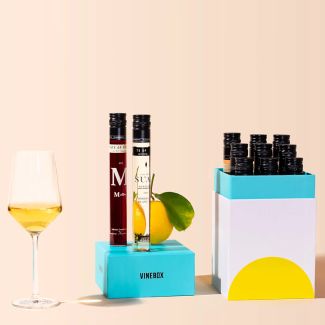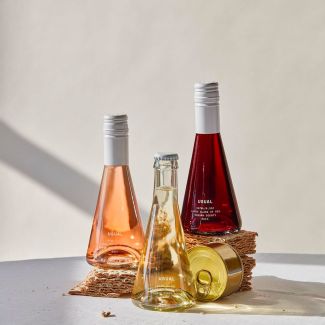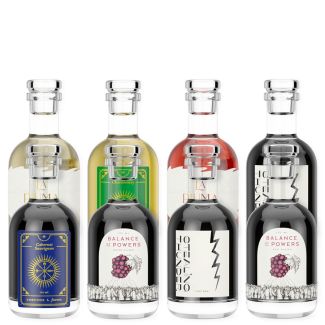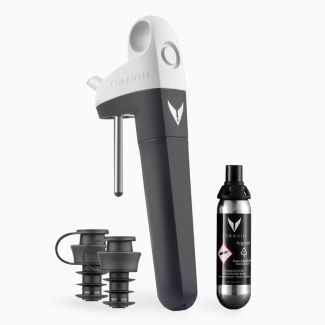

There Are More Ways to Cut Back than Going Cold Turkey
What is Dry January · Healthier Wine Choices · Portion Control
Ah, January, the time of year when we all promise ourselves that after a month of eating and drinking everything in sight we’re going to be healthier in the New Year. We join gyms or buy exercise equipment for our homes, we stock up on Lean Cuisine and Atkins bars, and some of us stop drinking for a month — a phenomenon called Dry January that was invented by Alcohol Change in the UK.
As someone who gave up on New Year’s Resolutions a while ago, I hardly begrudge all of the well-meaning folks who are trying to improve their quality of life by improving their health — and if they need a catalyst like a new year to do it, more power to them. Personally, I try to make these decisions at whatever point in the year I realize I’m not doing enough for my health and well-being rather than wait until everyone else is doing it, too, but that’s me (I tend to swim upstream).
The case for Dry January (and Sober October) is laid out well in this article. Short-term benefits of refraining can include: better sleep, weight loss, nicer looking skin, and a stronger immune system. A host of health-related magazines tout Dry January as a great thing for you to do, especially if you have an unhealthy relationship with alcohol, because less alcohol consumption is generally a good thing. This study conducted in the UK suggests successful participants in Dry January enjoyed more moderate alcohol consumption six months later. We don’t know what happened after six months.
Changing habits is hard — “...if you want to set your expectations appropriately, the truth is that it will probably take you anywhere from two months to eight months to build a new behavior into your life — not 21 days.” — James Clear
If you’re like a lot of people, you’ll go right back to your old drinking habits as soon as February 1 rolls around. Instead of suddenly abstaining altogether, I’m a fan of the incremental approach. A bunch of small changes, each tolerable in its own right, eventually adds up to big changes.
If you’re looking for a healthier way to keep wine in your life (in January, too), here are a bunch of small ways to do that without abstaining altogether.
FYI: I find great wine deals so you don’t have to. To keep me on the hunt, I earn a commission when you buy wine based on my recommendations.
Organic Wine. You’re probably already familiar with organic fruits and vegetables, and even organic meats and processed food. Wine is another consumable that can be organic. The same benefits of organic farming apply to grapes grown for wine: chemical-free, synthetic pesticide-free, and additive-free. Learn more about organic wine or find an organic wine club.
Low Alcohol Wine and Low Sugar Wine. Many of us are used to drinking wine that is 12.5-15% alcohol by volume (ABV). If alcohol is the part of wine you’re trying to avoid, exploring low-alcohol options is a great opportunity to cut back your alcohol intake without cutting back on the amount of wine you’re sipping.
If you’re not a wine geek, there’s an important thing to know about the relationship between alcohol and sugar in wine — they are both a function of how much sugar was in the grapes at the time they were harvested. Grapes that are high in sugar at harvest tend to make either sweet wines or high-alcohol (14-15% ABV) dry wines. Grapes that are low in sugar at harvest tend to make acidic, low alcohol (7-10% ABV) wines.
Also helpful to understand about wine: all dry wine is low in sugar. Wine gets to be dry by converting all of the grapes’ natural sugar into alcohol. Dry wine contains less than 10g/L of residual sugar (or 7.5g per 750mL bottle). Any wine with less than 1g/L of sugar is considered sugar-free (shop low sugar wines at Organic Wine Exchange).
The vast majority of wine in the world is intentionally produced in the 12-13.5% ABV range so you need to actively seek out low alcohol wines. Every bottle of wine is labeled with it’s ABV, so this is easy enough to check, but searching at some of the stores I recommend in this article will make the shopping process faster.
Some wines are low in both alcohol and sugar. You should expect these to be on the tart/sour/acidic side (perfect for anyone who likes sour beer, unsweetened lemonade, or pomegranate juice). Natural wines are often low alcohol and low sugar, so they’re a good place to look.
Trendy natural wine options like Glou Glou (French wine-industry code for low alcohol and bright flavors) and Piquette might be a great place to start (this is made by mixing water with grape pomace, a byproduct of winemaking and has a typical ABV of roughly 6-8%).
Shop low alcohol, low sugar, and low alcohol + low sugar wines at Organic Wine Exchange.
Vegan Wine. The first time most people hear the phrase “vegan wine” their response is something to the effect of “wait, what?” That’s because most people don’t think there are animal products (or byproducts) in wine. In this case, “fined” wine is sometimes filtered with something called Isinglass (a kind of gelatin obtained from fish, especially sturgeon), egg whites, or casein (a milk protein). Some wines are sealed with beeswax and some use agglomerated corks which use milk-based glues.
Basically, if your reasons for being vegan are health-oriented, I wouldn’t worry about seeking out vegan wine (the products in question are used in the making of the wine but are not actually in the wine). If your reasons for being vegan are about the ethics of eating living creatures or using them for the production of goods, you should seek out vegan wine.
Another way to have healthier wine habits is simply to drink less. I’ve heard people skip weeknight wine or limit themselves to just one glass on weeknights in order to cut back overall. This can be a tricky endeavor as most 750mL bottles just don’t keep well after they’ve been opened. Here are my suggestions on how to manage portion control with wine (willpower is up to you).
Smaller Bottles. Did you know that there’s a huge variety of wine bottled in half bottles? These 375mL bottles are a great way to make sure you and your favorite wine buddy only drink one glass at a time. It’s worth noting that you only get half the wine but you typically pay more than half the price – the costs associated with bottling wine don’t stop at the wine itself, so it costs a little more per ounce to get it bottled and distributed. There are also a number of wines produced in 500mL bottles worth exploring.
Pro Tip: Keep one of these half bottles around after you’ve emptied it. When you drink half of a full size bottle, you can carefully pour the leftover into this smaller bottle, cork it, and stick it in the fridge. This will greatly reduce the amount of oxygen the wine is exposed to and the refrigeration will slow the oxidation process, too.
These online wine stores all have an excellent selection of half-bottles. They're in order from biggest selection to smallest. Don't forget to check to see if each store can ship to your state before you get too excited about their options.
Single-Serving Wine. This is one of the better wine industry ideas from the last several years. I’ve seen a number of companies develop various forms of single-serving wine (beyond the super cheap stuff available in 187mL “splits”). My favorite options are tasting glasses from VineBox, six oz flasks from Usual Wines, six oz bottles from In Good Taste, and of course, wine in a can! All of these are terrific ways to help you stay on track with one glass per day.

VineBox
Nine 3.3oz tastes of wine. Sommelier-selected unusual wines from Europe. Currently sold out and offering a waitlist.
$79 for a 9-glass subscription
at VineBox

Usual Wines
Only available online — four great options to choose from: Red Wine, Reserve Red Wine, Rosé, and Brut Sparkling Wine.
$96 for 12 glasses
at Usual Wines

In Good Taste
Six ounce bottles of good-quality wine, mostly from California — full size bottles available for the wines you love.
$65 for 8 small bottles
at In Good Taste
Wine in Bladders & Boxes. If you have great willpower and you’re not super picky, it’s worth exploring wine in a box, and now in a bladder, which skips the extra packaging of the box altogether. It’s easy to pour yourself just one glass of wine packaged this way without worrying about it going bad.
If you’d like an option that isn’t mass-produced, I recommend checking out Irreverent Wines. These are sustainably produced, family-made wines from Walla Walla (both Washington and Oregon) and come in grown-up juice packs like Capri Sun (with a plastic tap instead of a straw, of course).
Wine Preservation Tools. Lastly, in the “I’ve got willpower” zone, it’s worth exploring wine preservation tools. You open a bottle, you drink a glass, you properly store it until you’re ready for the next glass (so it tastes just as good as the first one). So far the only reasonable options we’ve seen that are worth your money:

Coravin Pivot
No needles, no clamps, way less fuss than the original Coravin, making it perfect for casual wine drinking and short-term preservation. Comes in colors!
$99
at Coravin

Repour
A disposable cork replacement that sucks the oxygen out of the bottle while it’s resting in the refrigerator. Beloved by pros with robust by-the-glass programs.
$9.99 for a 4-pack
at Amazon